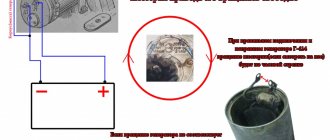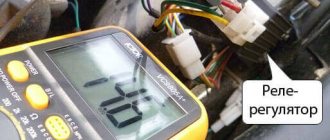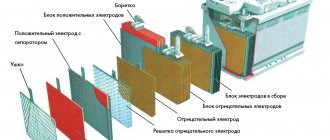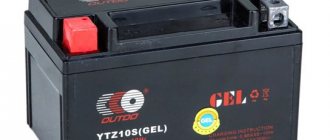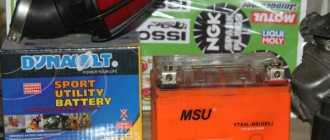Any battery-type batteries require regular recharging. Not everyone knows how to charge a gel battery. A specific electrolyte requires the use of special methods for restoring capacity. Following certain rules will help avoid element failure.
On the left is a gel battery using AGM technology, on the right is a gel battery using GEL technology.
What are gel batteries?
A gel battery is a conversion product of a classic battery. The liquid filler was replaced with a gel filler. The operating principle is no different from that of conventional lead-acid batteries.
There are 2 options for manufacturing such batteries:
- GEL technology. In this case, a microporous separator filled with silica gel is used.
- AGM technology. The body contains fiberglass impregnated with an acid composition. The same material serves as a separator.
Products produced using these technologies are used in automobile and shipbuilding. They power devices that require uninterrupted power supply. Batteries with a gel filler are rarely installed in cars.
However, they are in demand among owners of motorcycles and mopeds. The battery lasts at least 10 years. It works properly in any position. The tightness of the housing prevents leakage of electrolyte.
Advantages
The advantages of gel power sources include the following qualities:
Gel batteries are safe and have a long service life.
- High inrush current. The gel filler adheres tightly to the lead electrodes. This helps the user in winter.
- Impossibility of leakage of acid composition. If the housing is slightly damaged, the electrolyte does not drain out.
- Variety of installation options. The battery can be placed on a horizontal, inclined or vertical surface. This is due to the lack of liquid filler.
- Safety. The battery does not emit toxic or explosive fumes.
- Supplying current with stable strength and voltage. The parameters do not change even when the charge level drops to 30%.
- Long service life. The battery can withstand up to 700 discharge and charge cycles. Some models do not lose capacity even after 1000 charges.
- Insensitive to temperature changes. When heated or cooled, the gel-like electrolyte retains its properties.
Flaws
The negative qualities of GEL batteries include the following:
- The need to comply with operating rules. This is the only way to extend battery life. The battery must be properly charged and prepared for storage.
- The need to use automatic chargers that regulate voltage and current.
- Increased cost compared to classic batteries.
An example of specialized chargers for lead-acid and gel batteries from Optima and Universal.
Life time
As for the service life of gel batteries, it is worth highlighting the stated and actual figures.
For example, many manufacturers claim that their GEL batteries can last about 10 years. But this does not guarantee that in your specific case such a battery will be able to work out the entire specified period without problems.
Actual service life depends on exposure to extremely low and extremely high temperatures. At less than -30 degrees Celsius, electrochemical processes in the GEL battery will slow down, and at more than 50 degrees their intensity will increase. High temperatures also accelerate plate corrosion. If you do not maintain a constant high charge, you may encounter a sulfation problem. But you can’t keep such batteries on charge either.
Therefore, in order to bring the actual service life closer to the declared one, it is important to avoid deep discharge and overcharging, choose only dry rooms for battery storage and operate the battery in a temperature range from -35 to 50 degrees Celsius.
Can a gel battery be charged with a regular charger?
It is not advisable to use a regular memory. Connecting such a device directly can damage the battery beyond repair. When a high current is applied, the gel begins to melt. Liquefied filler cannot return to its original state. It continues to melt the remaining gel.
When charging a gel battery with a classic charger, the following problems may arise:
- Stops charging when reaching 90%.
- Inability to fine-tune parameters. It will not be possible to force the battery to accept current of inappropriate power.
- Battery overheating. In this case, you need to immediately turn off the charger. When using a non-automatic device, the user will have to monitor the charging process.
Basic rules for safe charging
When restoring the power of a battery with a gel filler, you must follow these rules:
- The charge level must be checked every 2-4 weeks. You can do this yourself using a multimeter. You need to start the engine and connect the probes of the device to the battery terminals.
- The voltage limit must be observed. This indicator should not exceed 14.5 V. During charging, the parameter changes. The deeper the discharge, the higher the current. As the charge is restored, the indicators decrease. Exceeding permissible levels leads to melting and boiling of the electrolyte.
- Do not try to open the case if the filler boils. This may cause the battery to explode and injure the user.
When fully charged, the voltage at the terminals of the gel battery should not exceed 14.5 V.
Cleaning the terminals
Over time, white salt deposits appear on the terminals. As a result, contact deteriorates, which often leads to a break in the circuit between the battery and the vehicle's on-board network. To avoid such problems, terminals and fastenings must be promptly cleaned of salts and deposits.
Fine-grained sandpaper is optimal for these purposes (clean without fanaticism). For prevention, after removing plaque and connecting the battery back to the wires, the terminals and fastenings can be treated with Vaseline or grease (also without fanaticism). The goal is to limit the access of moisture and oxygen to lead.
How to charge a gel battery?
Charging must be done using special devices. In this case, you need to set the basic parameters correctly.
Important parameters and features
The intervals between procedures must be at least 6 months. It is necessary to restore the battery's energy potential completely. Otherwise, the battery capacity will decrease over time. It is quite difficult to restore this figure.
The duration of the charging cycle depends on the battery capacity and charging current. The first parameter is divided by the second. With a capacity of 60 A/h and a current of 0.6 A, the cycle duration is 10 hours. Special chargers signal the completion of the procedure.
Charging procedure step by step
Charging a gel battery is done as follows:
- Turn on the charger and measure the current. This will help you choose the optimal operating mode.
- The battery is charged with a current of the same strength that was automatically calculated by the device.
- After 2-3 hours, charging is interrupted. This helps prevent the case from overheating.
- After waiting for the battery to cool, the procedure is resumed, reducing the current. We must not forget about the need to measure the parameter during the cooling period of the battery. If you miss this moment, the charger turns off automatically and the cycle does not resume.
- When the required current is reached, the device is turned off. Non-automatic devices continue to function. Special chargers are equipped with regulators that prevent the gel from melting when the battery heats up.
Instructions for charging a motorcycle battery
12.7 V is the normal voltage of a gel battery for a motorcycle.
The battery of a snowmobile or motorcycle has a lower capacity than the car's power source. A universal car charger does not produce low currents.
Smart devices, such as Benton BX, are used to charge a motorcycle battery. The battery is examined using a multimeter.
The device measures the voltage at the terminals. A value of 12.7 V is considered normal. At a lower value, the gel battery requires recharging.
To extend the battery life, charge it once every 2 months. After long-term storage, the charge is restored within 12-14 hours by applying a current equal to 10% of the capacity. Do not turn off the charger until power is fully restored. You need to monitor the temperature of the battery case.
Marking
In the case of gel batteries, the corresponding marking in the form of GEL is applied to the device body.
It is a mistake to call AGM batteries gel batteries, since different technologies are used for their production.
There is also a marking that displays the main parameters of the battery, its production date, service life, etc. But here, each manufacturer has its own marking principle. Therefore, it is advisable to familiarize yourself with the nuances of the designation of batteries from the manufacturer you decide to give preference to.
What care does a gel battery require?
You cannot use the vehicle until the battery is completely discharged. When the charge decreases, the battery does not stop functioning. However, the capacity decreases, due to which the battery will not be able to accept the required amount of energy. You need to purchase a multimeter and keep it with you at all times. This will help you detect the low battery in time, connect the charger and recharge.
Additionally, it is recommended to perform the following actions:
- regularly clean the battery case from dust and dirt;
- Once every 3 months, completely discharge and charge the battery;
- check the correct connection of the terminals.
Design features
If we talk about what a standard gel car battery consists of, then we can highlight several elements. Namely:
- positive electrodes;
- negative plates;
- electrolyte in the form of a gel;
- overpressure relief valves;
- terminals;
- plastic sealed case;
- separator plates.
The operating principle is the same as other lead-acid batteries. That is, the battery, when charged, supplies the accumulated current to start the engine and power consumers when the generator is inactive. When a charge is released, the voltage gradually drops, and the density of the electrolyte decreases.
Therefore, it cannot be said that a gel battery is in fact significantly different from the acid version of the battery, where there is not a gel inside, but a liquid medium. In addition to sulfuric acid and distilled water, a thickener is also added to gel batteries.
Because of this, many are interested in how to distinguish a gel battery from a liquid lead-acid battery. Everything is simple here. Focus on the markings. On the gel ones you can see the inscription GEL. Plus, all GEL batteries are maintenance-free, their housing is completely sealed.
How to extend the operating life of the device?
Despite the fact that the 12 Volt gel battery is maintenance-free, its service life can be extended. A swollen battery cannot be resuscitated; it must be disposed of. In this case, the gel is separated from the plates, and energy production becomes impossible. Internal damage is difficult to detect. These include wear of the fiberglass, electrodes or electrolyte.
When the filler dries, restoration is possible. To do this, remove the plastic cover and remove the rubber valves. Using a syringe, pour 2 ml of purified water into each jar. The liquid should slightly cover the plates. After moistening the gel, excess water is pumped out with a syringe. The caps and lid are returned to their place.

